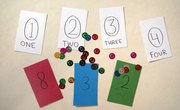Teaching important values to young children is not always as easy as we would like it to be. But, adults who can find ways to teach values through a game or activity that children enjoy will likely recognize immediate understanding among these children. This is an instrumental part of a child's development because a profound appreciation and understanding of values will result in a child becoming well-rounded and kind. Children can begin to learn about values and understand their significance by engaging in activities that focus on the purpose behind specific values and how they affect others and ourselves.
Kindness
This game is suitable for a household or for a classroom. Establish a chart that recognizes the acts of kindness a child performs. List all the children in the class, or the home, on the chart. Next, create a column next to their names, and provide each child with a packet of stickers. The stickers can be balloons, hearts, angels or even flowers. Each time you notice a child doing a good or kind deed, let them place a sticker in her column. At the end of each week, award a prize, such as a piece of candy, for every sticker that was earned.
Gratitude
Ask each child to write a list of all the things he would like for his next birthday or upcoming holiday. After everyone is finished, ask the children to count how many items they wrote down and write it at the top of their page. Instruct them to then multiply the number by three. However much the equation totals equates how many things the child must then write down that they are thankful for. The first student to finish wins a prize. The game teaches students to remember to be grateful for the things they have because they can visualize that those items far outweigh the others.
Sharing
Give all students a puzzle and inform them that the first student to complete the puzzle will win a prize. The students can decide to work on one puzzle together in a team or try and complete the puzzle on his or her own. If they work as a team, they must split the prize; if they work individually, they can keep the prize themselves. The puzzle must be completed in five minutes and it should be made clear to students that they are likely to finish the puzzle in time if they work with a friend. The students will see that by deciding to share the prize and work together they are much more likely to gain some of the reward instead of none at all. To ensure students understand the objective, teachers can also do the game in two rounds; one where the students work alone, another with a classmate.
Honesty
Write down a short statement on a piece of paper, such as "Monkeys like to eat bananas." Fold it up, and hand it to a child. Instruct her to rewrite the statement on another piece of paper, but she has to change one word of the sentence. For example, she could write, "Monkeys like to eat cabbage." She must then pass the note to the person next to her, who repeats the process. Once everyone has had a turn rewriting the sentence, recite the original sentence. Then, take the final written version and read that to them as well. The two versions will likely be very different from each other. Explain to them that the game is similar to when we tell a lie, even if it is a small lie. The next person who hears it may change it, even if only slightly, when they retell it, and so on. Relay to them that this is how big lies can be created and could result in hurting someone's feelings, which is why it is important to always be truthful.
Related Articles
Writer Bio
Michelle Barry graduated from Salve Regina University with a Bachelor of Arts in English. Since then, she has worked as a reporter for the Wilbraham-Hampden Times, an editor for Month9Books and Evolved Publishing, editor and has spent the past seven years in marketing and graphic design. She also has an extensive background in dance.











